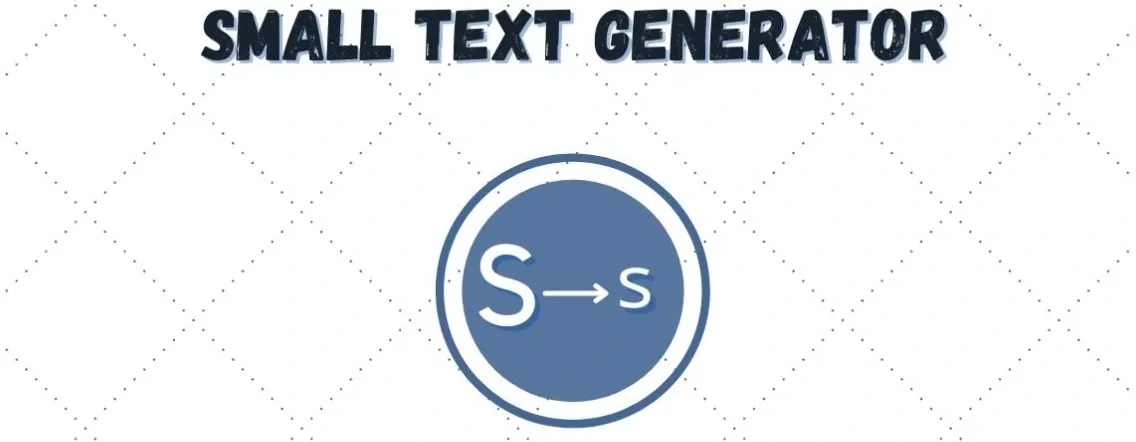Creating landing pages with a small text generator

Creating landing pages with a small text generator by https://smalltextgenerator.net/ can be a useful and efficient way to generate content quickly. Here are some steps to help you create landing pages using a small text generator:
- Define your audience and purpose: Before you start writing, it's essential to define who your target audience is and what the goal of the landing page is. This will help you write a copy that speaks directly to your audience and motivates them to take action.
- Use a small text generator: There are many small text generators available online that can help you generate copy quickly. Some popular ones include Copy.ai, Lumen5, and Textio. Simply input your keywords or prompts, and the generator will provide you with several possible options to choose from.
- Customize the generated text: While a text generator can be a useful tool, it is essential to customize the generated text to fit your brand voice and messaging. Review the text carefully, and make any necessary changes to ensure it aligns with your brand tone and messaging.
- Use attention-grabbing headlines: The headline is the first thing visitors will see when they arrive at your landing page. Make sure your headline is attention-grabbing and clearly communicates the value proposition of your product or service.
- Use clear and concise copy: Keep your copy short and to the point. Use bullet points and subheadings to break up the text and make it easy to read. Avoid using technical jargon or complex language that may confuse visitors.
- Include a clear call-to-action (CTA): The purpose of a landing page is to drive action, whether that's making a purchase, signing up for a newsletter, or downloading a white paper. Make sure your CTA is clearly and prominently displayed on the page.
- Test and iterate: Once your landing page is live, track its performance and make changes as necessary. A/B test different headlines, copy, and CTAs to optimize the page's conversion rate.
- By following these steps, you can create effective landing pages using a small text generator that drives action and helps you achieve your business goals.
Introduction of small text generator:
- A small text generator is a software tool that uses artificial intelligence (AI) and natural language processing (NLP) algorithms to generate text based on input keywords or prompts. Small text generators can be used to create a variety of content, including headlines, product descriptions, social media posts, and even entire articles.
- Small text generators are designed to save time and effort for content creators by automating the process of generating text. They can produce multiple options quickly and efficiently, allowing writers to choose the best option for their needs.
- Many small text generators use machine learning algorithms to improve their output over time, learning from user feedback and adjusting their models accordingly. This means that the more they are used, the better they become at generating high-quality text.
- Small text generators can be a useful tool for businesses and individuals who need to create large amounts of content quickly, such as marketing teams, social media managers, and bloggers. They can help save time and effort while still producing high-quality, engaging content.
How do you write text on a landing page?
When writing text for a landing page, there are a few key elements to keep in mind to ensure that the page is effective in achieving its goals. Here are some tips to help you write effective text for a landing page:
Define your audience: Before you start writing, it is essential to define your target audience. Who is the landing page for? What are their pain points, goals, and interests? Understanding your audience will help you write a copy that speaks directly to their needs and motivates them to take action.
Use an attention-grabbing headline: The headline is the first thing visitors will see when they arrive at your landing page. Make sure it's attention-grabbing and clearly communicates the value proposition of your product or service. Use a headline that is concise and to the point, and use formatting such as bold or larger font to make it stand out.
Use clear and concise copy: Keep your copy short and to the point. Use bullet points and subheadings to break up the text and make it easy to read. Avoid using technical jargon or complex language that may confuse visitors.
Highlight the benefits: Visitors to your landing page want to know what's in it for them. Make sure you highlight the benefits of your product or service in clear, concise language. Use bullet points or bold text to make these benefits stand out.
Include social proof: Social proof is a powerful tool in persuading visitors to take action. Include customer testimonials, case studies, or other forms of social proof that demonstrate the effectiveness of your product or service.
Use a clear call-to-action (CTA): The purpose of a landing page is to drive action, whether that's making a purchase, signing up for a newsletter, or downloading a white paper. Make sure your CTA is clearly and prominently displayed on the page. Use action-oriented language, such as "Sign up now" or "Get started today."
Test and iterate: Once your landing page is live, track its performance and make changes as necessary. A/B test different headlines, copy, and CTAs to optimize the page's conversion rate.
By following these tips, you can write effective text for a landing page that drives action and helps you achieve your business goals.
How do you text from a web page?
If you want to copy text from a web page, you can follow these simple steps:
Highlight the text: Use your mouse or trackpad to highlight the text you want to copy. Click at the beginning of the text and drag the cursor to the end of the text while holding down the left mouse button.
Copy the text: Once the text is highlighted, right-click the mouse or trackpad and select "Copy" from the dropdown menu. Alternatively, you can use the keyboard shortcut "Ctrl+C" (Windows) or "Command+C" (Mac) to copy the text.
Paste the text: Open the program or application where you want to paste the copied text, such as a word processor, email client, or chat window. Right-click the mouse or trackpad and select "Paste" from the dropdown menu. Alternatively, you can use the keyboard shortcut "Ctrl+V" (Windows) or "Command+V" (Mac) to paste the text.
Note that some web pages may have text that is protected from copying. In these cases, you may need to use a different method, such as taking a screenshot of the text or using a third-party tool to extract the text.
How do I write content for my website home page?
- Writing content for your website's homepage is an essential step in creating a successful online presence. Here are some tips to help you write effective content for your website's home page:
- Define your target audience: Before you start writing, it's important to understand who your target audience is. Who are they? What are their needs and interests? What are their pain points? By understanding your audience, you can write a copy that speaks directly to their needs and motivates them to take action.
- Start with a strong headline: Your headline is the first thing visitors will see when they land on your homepage. Make sure it's attention-grabbing, concise, and clearly communicates the value proposition of your website. Use formatting such as bold or larger font to make it stand out.
- Use clear and concise language: Keep your copy short and to the point. Use bullet points and subheadings to break up the text and make it easy to scan. Avoid using technical jargon or complex language that may confuse visitors.
- Highlight the benefits: Visitors to your homepage want to know what's in it for them. Make sure you highlight the benefits of your product or service in clear, concise language. Use bullet points or bold text to make these benefits stand out.
- Include social proof: Social proof is a powerful tool in persuading visitors to take action. Include customer testimonials, case studies, or other forms of social proof that demonstrate the effectiveness of your product or service.
- Use a clear call-to-action (CTA): Your homepage should have a clear and prominent CTA that encourages visitors to take action. Make sure the CTA is relevant to your audience and easy to find. Use action-oriented language, such as "Sign up now" or "Get started today."
- Use visuals: Use images or videos to break up the text and make your homepage more engaging. Make sure the visuals are relevant to your message and enhance the user experience.
- Test and iterate: Once your homepage is live, track its performance and make changes as necessary. A/B test different headlines, copy, and CTAs to optimize the page's conversion rate.
- By following these tips, you can write effective content for your website's homepage that engages visitors, communicates your value proposition, and drives action.
Last words:
Thank you for the opportunity to assist you with your questions. Remember, writing effective content for your website is a continuous process of refinement and improvement. Keep testing and iterating to optimize your website's performance and deliver value to your audience. Good luck with your website!





